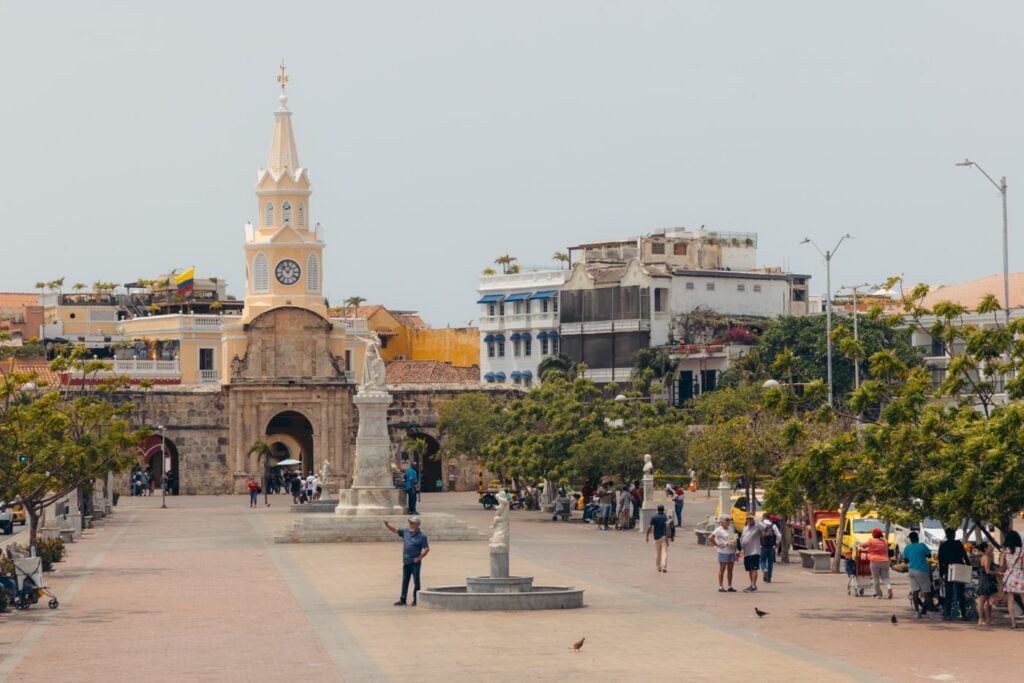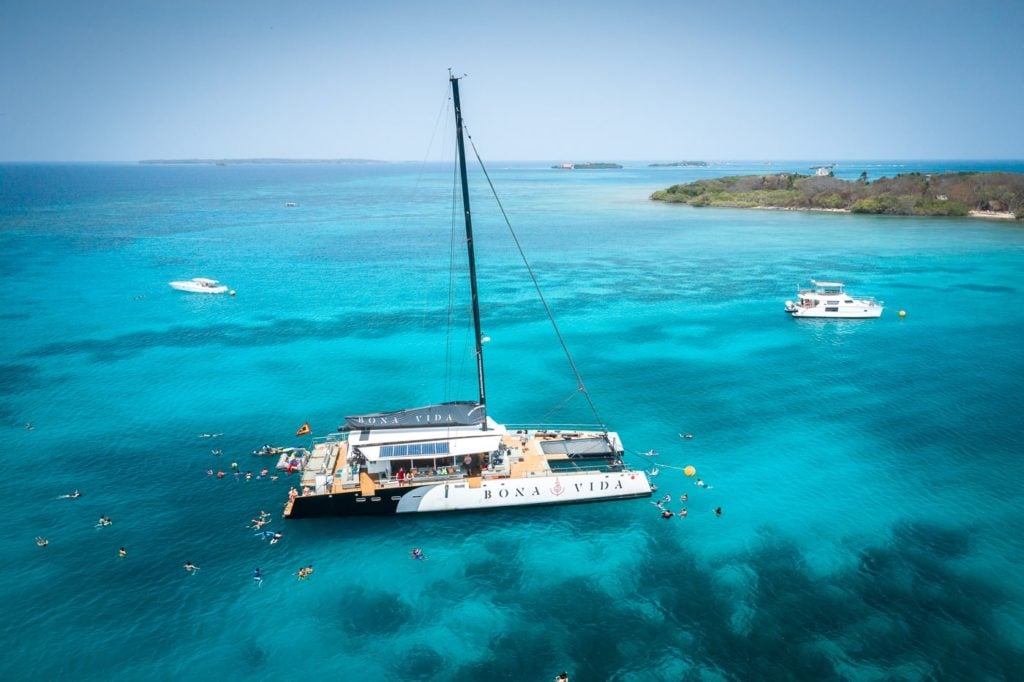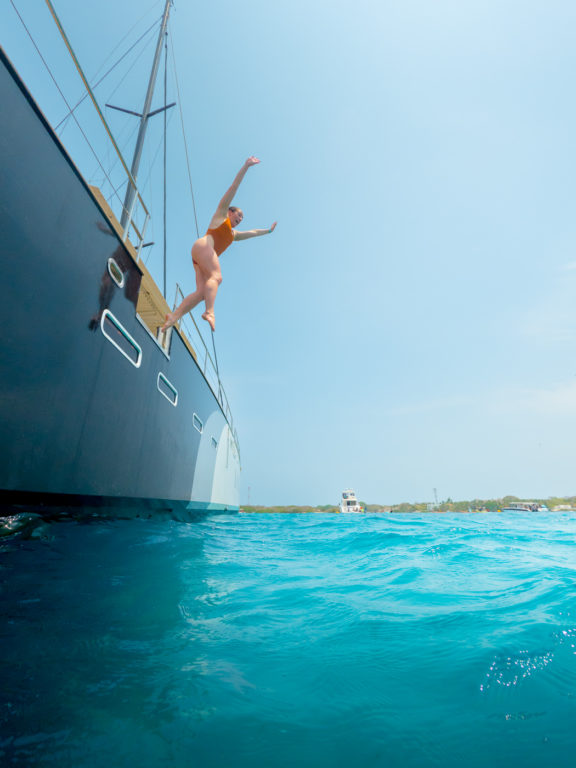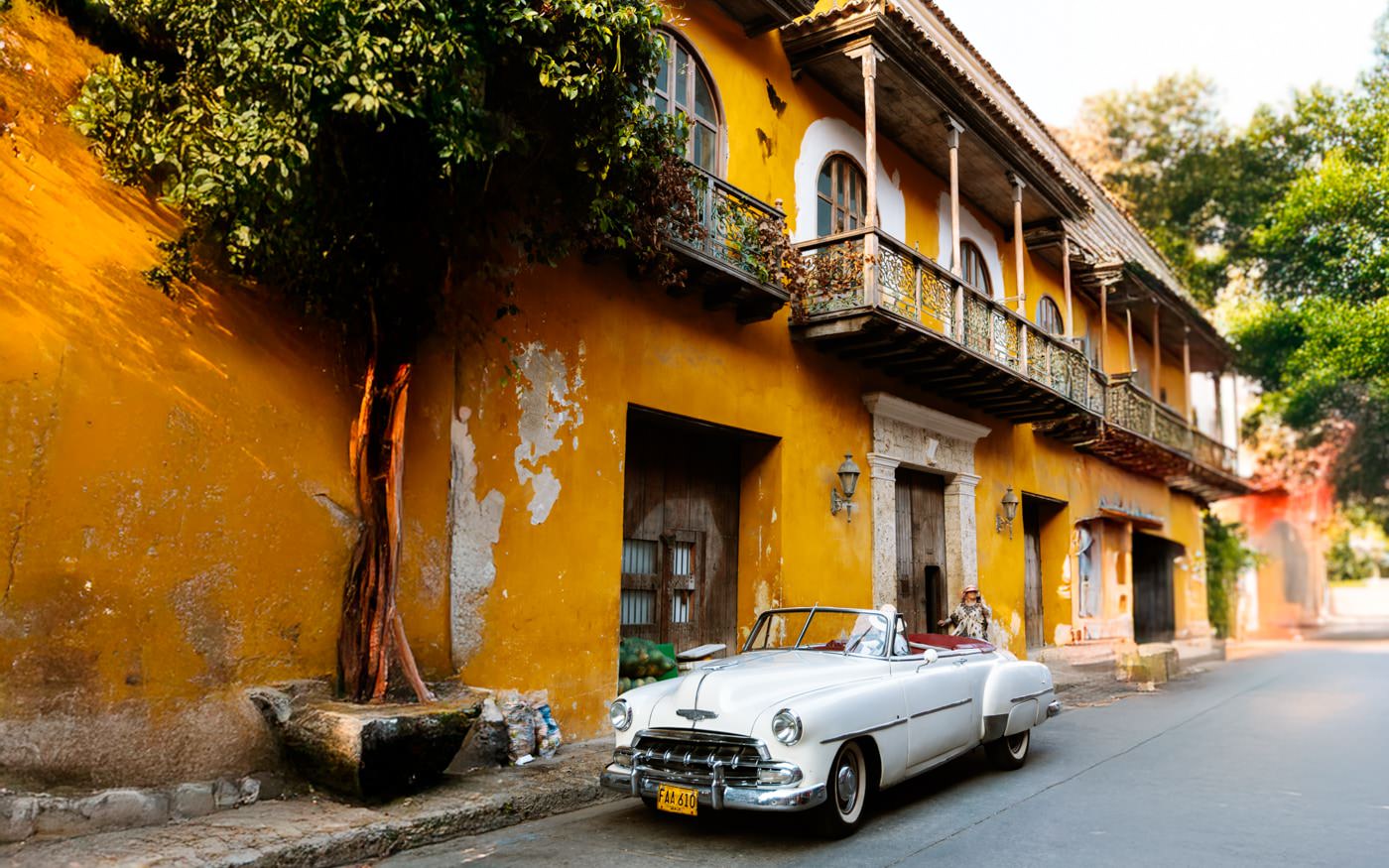As Colombia’s most visited city and one of South America’s oldest colonial settlements, Cartagena makes it onto most Colombia itineraries and has a reputation as the most colorful and vibrant place on the country’s north coast.
I was prepared to hate Cartagena; it was the final stop I was visiting in Colombia, and every traveler I had met had warned me that it was crowded, touristy, and hot. Most people told me to only spend a day there, and some even advised me to skip it altogether!
I decided to make my mind up for myself – if I hated it, I could escape to the islands or another town on the Caribbean coast. Ten days later, I was still there… so it’s safe to say my expectations of Cartagena were exceeded!
That said, three days in Cartagena is a good amount of time to spend in the city. People weren’t lying; it is crowded, touristy and hot – and it can definitely be quite overwhelming. This Cartagena itinerary spends two full days exploring the historical and artistic centers of Cartagena, and one day hopping around some of the beautiful nearby Caribbean islands.
Day 1
Morning: Cartagena Bike Tour
One of the things that makes Cartagena so special is its history, which can still be seen in its streets today as the walled city is one of the most well-preserved colonial strongholds in the Americas. The story of Cartagena is packed with drama—pirates, gold, and battles for control over one of Spain’s most important ports.

In the 16th and 17th centuries, Cartagena's coastal location meant that it was a major Spanish port, used to ship gold, silver, and other goods from South America to Europe. This made it a prime target for pirates and enemy nations. The most infamous attack came in 1586 when English privateer Sir Francis Drake raided the city, looting it and setting parts of it on fire. After that, Spain decided it was time to fortify Cartagena, and the walled city was built.


You can explore the walled city on your own, but without a guide it’s hard to understand the history behind the area. I think the most fun way to bring Cartagena's history to life is by taking a guided bike tour. Your guide will tell stories of the battles that shaped Cartagena while cycling through plazas, past centuries-old churches, and along the massive stone walls that once protected the city.
This is the tour I opted for as I liked that it covered the walled city and made lots of street food and drink tasting stops, before moving into the Getsemaní district. Getsemaní is dubbed by many as Cartagena's ‘heart and soul’ - originally a working class district, Getsemaní was home to enslaved and freed people who played a role in Cartagena's liberation from Spain in the early 1800s.

After the city gained independence, the neighborhood remained one of the city's poorest and most overlooked areas. In recent years however, it’s undergone huge regeneration and has turned into Cartagenas cultural and nightlife hub.
The streets of Getsemaní are lined with murals and street art, so during your bike tour, the guide will give you an insight into the stories and behind the colorful artworks, enabling you to get a sense of Getsemanís history and importance as part of Cartagena.
Afternoon - Castillo de San Felipe de Barajas
The next stop on this Cartagena itinerary is a visit Castillo de San Felipe de Barajas, the massive fortress that looms over the city. It was built in the 1600’s by the Spanish to protect Cartagena from threats, and despite coming under attack numerous times, the castle never fell into enemy hands.
You can spend a few hours exploring the castle - it’s the largest castle the Spanish built in South America, and covers a whopping 16 acres of land. I really recommend hiring a guide; this costs around 20,000 COP but the additional insights and context they provide really bring the castle's history to life. In addition to this, there are a lot of hidden passageways and tunnels that are harder to find without a guide, so this is another reason it’s worth booking one.

Evening: Sunset Boat Trip
The sunsets in Cartagena are some of the best in Colombia, and one of the most popular ways to enjoy them is to book a boat trip and get out on the water. Watching the sun dip into the Caribbean sea behind the Bocagrande skyline is a pretty incredible sight, and it’s a great way to round off day one of your three day Cartagena itinerary.
You’ll find plenty of choices when it comes to sunset boat trips, and there are different boats for different vibes - from a party cruise on a pirate ship, to romantic private yacht trips, and everything in between. Most cruises last between 1.5 - 2 hours, and sail around the Cartagena bay.

Since I was traveling solo, I booked the sunset party boat trip that my hostel was organizing. This was a great way to meet people, and the whole boat group ended up going for drinks together once we were back on dry land. If you’re a solo traveler and are keen to meet people, it’s definitely worth booking your boat trip this way - if your accommodation isn’t offering one, you can use Hostelworld to check what trips and activities other hostels in the city have planned each day.
Alternatively, if you’re looking for something a bit more laid back, the sunset boat tour below looks like the best option online. It’s on a catamaran - this is important because the water surrounding Cartagena can be very choppy, and a catamaran is a much smoother way to sail. Additionally, catamarans are a lot more spacious, so you’ll have plenty of room to kick back and enjoy the sunset.

Day 2
Morning/Afternoon - Island Hopping Boat Trip
One of Cartagenas main appeals to travelers is its geographical location on the sparkling Caribbean coast, and no Cartagena itinerary would be complete without spending some time enjoying the beach.
The beaches surrounding the city are nice, but you’ll find better ones on the islands dotted offshore. There are a few islands to choose from, and most of them are part of two main archipelagos - the Rosario Islands and the San Bernardo Islands.

Most travelers opt for a day trip to the Rosario Islands, as these are closer to the city, and reaching them involves a less bumpy journey than to the San Bernardo Islands. The best way to visit is by booking an island hopping tour - these allow you to visit various different islands in one trip, and if you’re only in the city for three days, it’s the best way to see as much as possible.
There are heaps of island-hopping tours available to book, both online and with local tour providers. I chose to book this boat tour online when I was in Cartagena, as it was the option that provided stops on the most different islands, and it was also one of the only ones I found with a snorkeling stop.
The first stop on the trip is at Tierra Bomba, an island with an interesting history - it was fortified to protect Cartagena by the Spanish in the 18th century, and the fort remains can still be seen today. After a guided tour here, it’s back on the boat to the snorkel stop which is at a marine site teeming with sea life. After that, the rest of the afternoon is spent hopping between the Rosario Islands, visiting different white-sand beaches and soaking up the blissful Caribbean vibes.


Evening: Sunset Rooftop Bar
Cartagenas's historic charm, warm Caribbean evening temperature, and epic sunsets make this the perfect city for rooftop bar hopping. There are plenty of spots scattered around the old city to choose from, with many offering views of colonial rooftops, bustling plazas, and the city skyline.

Rooftop bars in Cartagena usually start filling up just before sunset, so start your evening rooftop-hopping just before 6 om. I tested a few rooftop bars during my time in Cartagena and the one with the best view was undoubtedly on top of the Movich hotel. The view stretches from the clock tower right across the water to Bocagrande - and if you’re there for sunset, you’re in the perfect position to watch the sun dip behind the skyline.
After a few sundowners, head to the nearby Mirador Gastrobar, where you can grab something to eat on their rooftop. The food here (especially the seafood!) is fantastic, and it’s a great people watching spot as you can see the street performers below. It’s pretty reasonably priced as well, making it a great spot to spend the evening at.
If you want to carry on after this, you’ll find plenty of options - Cartagenas rooftops really come alive after dark, and many of them turn into huge open-air dancefloors.
My two favorite rooftops for a night of dancing were Alquimico and Eivissa; both are excellent spots with good cocktails and even better music. It’s worth heading before 11 pm most nights, as large queues can build up pretty quickly and often in Cartagena you’ll have to pay an entry fee after 11. It’s worth noting that some of these bars are pretty strict on dress codes - I was turned away for wearing sandals, which hasn’t happened anywhere else in South America!

Day 3
Morning: Totumo Mud Volcano
One of the most unique activities to do in Cartagena is take a trip to The Totumo Mud Volcano. This is a small volcano which is around a one-hour drive northeast of the city, and is famous for the thick, mineral-rich mud that it’s filled with instead of lava. The dense mud supposedly has healing properties, so people visit to bathe in it.
It’s a 50 step climb up to the top of the mini crater, where guides are on hand to help you submerge into the bubbling mud. Bathing in the mud volcano is easily one of the strangest things I’ve ever experienced - it’s hard to even put into words! You feel surprisingly weightless (just like you would in water), but there’s a strange gritty texture, and inconsistencies in the mud's temperature. It was very relaxing though, and my skin felt amazing after the mud was rinsed off!

You have two options for getting to the volcano; either you can book a tour, or hire a driver for the morning. I opted to book a tour from my hostel as it was cheaper than paying for a driver, and it was a really interesting journey as the guide gave us lots of information about the areas we were passing along the way. This mud volcano tour is a similar price to the one I joined, and looks to offer the same experience.
My one piece of advice is to bring a plastic bag to seal your muddy clothes in after getting changed - my swimsuit was fully dried out by the time I got back to my hostel, and the dried, caked-on mud was tricky to get out.

Afternoon: Parque Centenario and Museo del Oro Zenu
After grabbing some lunch (and a very thorough shower!) walk to Parque Centenario, a small green space right outside the walled city. Originally built in 1911 to celebrate Colombia’s independence, this park is now a shady retreat where locals hang out, street vendors sell fresh fruit, and you might even spot a few unexpected residents—sloths, monkeys, and iguanas!
Yes, you read that right - there’s a sloth that lives in the park, and if you’re lucky, you’ll see it hanging from the trees. Keep your eyes peeled, and don’t forget to look up - if you’re having trouble spotting it, just ask one of the nearby local vendors, as they usually know where the sloth is hanging out that day.

Just a few minutes from Centennial Park, the Museo del Oro Zenú is a hidden gem that often gets overlooked. It’s a small, free museum showcasing Colombia’s indigenous Zenú culture, famous for its intricate goldwork and advanced irrigation systems long before the Spanish arrived.
The exhibits include stunning handcrafted gold jewelry, ceremonial masks, and ancient artifacts, all beautifully displayed with explanations in Spanish and English. It’s a quick visit (30 - 45 minutes max) but super interesting, especially if you want to learn about the indigenous history of the region before the arrival of the Spanish.


Evening: Cafe Havana
In my opinion, no Cartagena itinerary would be complete without a visit to the famous Cafe Havana. This is one of the coolest live music spots in the city, and I absolutely loved the atmosphere here in the evenings. The bar has a cozy, no-frills vibe, but as soon as the live salsa band starts up, it really comes alive.
They play a mixture of traditional Cuban salsa music and twists on more modern songs, and the music is very infectious - it doesn’t take long before the floor is filled with salsa dancers. There’s some pretty impressive dancing here and it’s amazing to just sit back and take it all in. Be warned though, you’ll have lots of locals trying to get you up for a dance if you’re sat down!
There’s a pretty expensive entry fee to get in (25,000 COP). I avoided visiting at first as I thought there was no way it could be worth paying that - but after seeing the queues out the door every night, curiosity got the better of me. It was definitely worth the money, and you can easily spend the whole evening there.

Where to Stay in Cartagena
Cartagena offers a variety of neighborhoods suited to different travel styles, from the historic charm of El Centro to the vibrant energy of Getsemaní, the beachfront luxury of Bocagrande, and the upscale tranquility of El Laguito.
Whether you're looking for a high-end stay in a colonial boutique hotel, a budget-friendly hostel with a social atmosphere, or a beachfront resort with ocean views, this guide to where to stay in Cartagena covers the best options, otherwise take a pick from my top 3 favorites below.

1. Hyatt Regency Cartagena Luxury
A beachfront luxury hotel in Bocagrande with ocean views, infinity pools, a spa, along with fine dining. Great for families and couples.

2. Casa Del Pozo Boutique House Mid-Range
A stylish boutique hotel Getsemaní with a pool, and a lively vibe. Ideal for couples and mid-range travellers wanting a quiet area.

3. República Hostel Budget
A social hostel in the Old City with dorms, private rooms, and a bar. A great option for solo travelers and backpackers.
Where to Go Before/After Cartagena…
Cartagena is well connected to the rest of Colombia through its international airport and excellent bus links - so it’s pretty easy to reach from most places. My top recommendation of where to visit before or after your time in the city is the Island of San Andres.
This Caribbean island is a little slice of paradise. Despite being Colombian, it’s actually closer to Nicaragua, and for this reason, it doesn’t seem to be on most travelers Colombia itineraries - meaning it’s unspoiled by mass tourism. The tiny island measures less than 30 km2, and is made up of idyllic white sand beaches and palm-fringed shores, with a completely laid-back tropical vibe. It’s one of the best spots in the area for scuba diving and snorkeling, and its dive sites are world-renowned.
You can find cheap flights from Cartagena to San Andres almost daily, and it’s a super quick journey - so it’s really worth adding into your Cartagena itinerary.

Cartagena FAQ’s:
How Many Days Do I Need in Cartagena?
3-4 days is an ideal amount of time for Cartagena, but you can easily find things to do if you want to spend a bit longer in the city, as there are some great day trips you can take to nearby attractions.
Is Cartagena Safe for Tourists?
Cartagena is far from the most dangerous city in South America, and it’s Colombia's most visited city - plenty of tourists visit without any issue. I felt completely safe here; the walled city and Getsemaní are very compact and busy at night, so it was easy to walk around alone without feeling at risk. That being said, petty crime incidents do occur here, and things like pickpocketing are more common in some parts of the city than other places in Colombia.
Both Getsemaní and the walled city can be very crowded and there are a lot of distractions from street performers and hawkers. If you stay alert when you’re in crowds, keep an eye on your belongings, and use common sense, you can decrease the likelihood of anything happening to you.
Is Cartagena Expensive?
I found Cartagena to be on the more expensive side for Colombia, but it’s still very reasonably priced by world standards. You can save money by booking your accommodation in advance, as prices rise quite dramatically the closer you book to your stay - especially on weekends.
Street food is very easy to find in Cartagena and is very affordable, so if you’re traveling on a budget this is another way to keep costs down. I also noticed in a handful of more touristy restaurants that the English and Spanish menus were priced differently, so that’s something to keep an eye on as well.
What Time of Year is Best For Visiting Cartagena?
The dry season runs from December to April, and this is the best time to visit Cartagena as it’s much less hot and humid in these months. This is the busiest time of year in the city though, so visiting outside of the dry season means less crowds and lower prices.
Can I Drink The Tap Water in Cartagena?
No, unlike cities like Medellìn, the tap water isn’t safe to drink in Cartagena. A lot of accommodations have water purifiers, though, so it’s worth bringing your own reusable bottle to fill up.
I hope you've enjoyed my action-packed 3-day itinerary to Cartagena. I've written a bunch of other articles about Colombia, including a guide to hiking to the Lost City (one of my favorite experiences in Colombia).
Otherwise, check out some of my other articles or some written by Olly as well!
- Things to do in Medellín: Olly's top travel guide with fun activities and top highlights in the city of Medellín
- Things to do in Minca: Discover Olly's favorite hikes, beautiful fincas, epic jungle waterfalls, and all-around relaxing vibes.
- Things to do in Guatapé: We Seek Travel's guide to Colombia's most scenic Antioquian town. Discover vibrant streets, traditional street art, and the famous Piedra del Peñol.


